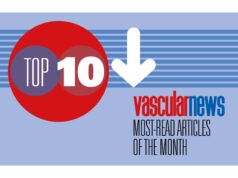 New data on asymptomatic carotid disease, key developments in below-the-knee (BTK) interventions, and evidence to suggest wearable activity monitors could benefit intermittent claudication patients all feature in our top 10 most read stories of February 2021.
New data on asymptomatic carotid disease, key developments in below-the-knee (BTK) interventions, and evidence to suggest wearable activity monitors could benefit intermittent claudication patients all feature in our top 10 most read stories of February 2021.
1. New data find strong association between asymptomatic carotid stenosis and future stroke risk
Reporting a strong association between asymptomatic carotid stenosis and future stroke risk, Dominic Howard (Oxford University Hospitals NHS Trust, Oxford, UK) and colleagues write in The Lancet Neurology that their findings are “contrary to the assumptions of current guidelines and the findings of subgroup analyses of previous randomised controlled trials”.
Acute kidney injury is a common complication after intervention for peripheral arterial disease (PAD), and is associated with “medium-term mortality” following percutaneous transluminal angioplasty (PTA), a new study in the British Journal of Surgery (BJS) finds.
3. Endovascular aneurysm repair linked to higher readmission rates
Researchers from the University of Missouri School of Medicine have discovered that while endovascular aneurysm repair (EVAR) is more commonly utilised for ruptured abdominal aortic aneurysms (rAAA), shortens hospital stay, and has a lower initial mortality rate, the odds of hospital readmission after EVAR are 1.5 times higher compared to traditional open repair.
4. LINC 2021: Novel approaches and new data for BTK interventions revealed
In a late-breaking trial session at LINC 2021 (The Leipzig Interventional Course, 25–29 January, online), key updates on BTK interventions were in the spotlight.
5. Use of wearable activity monitors could benefit intermittent claudication patients, study suggests
There is some evidence to indicate that the inclusion of wearable activity monitors in home-based exercise therapy improves walking ability and quality of life in patients with intermittent claudication. This is the main finding of a systematic review that appeared online in the European Journal of Vascular and Endovascular Surgery (EJVES).
Among individuals with “significant vascular surgical pathology,” John Houghton (University of Leicester, Leicester, UK) and colleagues have found that the prevalence of cognitive impairment is high and is associated with worse postoperative delirium (POD). Therefore, they suggest that screening elective vascular surgery patients for cognitive impairment “may be appropriate”.
7. Primary endpoint results from Treo pivotal study published
Following recent approval by the US Food and Drug Administration (FDA) of the Treo abdominal aortic stent graft system for the treatment of patients with abdominal aortic aneurysms (AAA), Terumo Aortic announced the publication of the primary endpoint results from the investigational device exemption (IDE) pivotal study in the Journal of Vascular Surgery.
8. USPSTF recommends against general screening for asymptomatic carotid artery stenosis
In a recommendation statement published on 2 February in The Journal of the American Medical Association (JAMA), the US Preventive Services Task Force (USPSTF) advises against screening for asymptomatic carotid artery stenosis in the general adult population. This recommendation is consistent with the task force’s 2014 statement on the topic.
9. Front Line Medical Technologies receives Health Canada approval for COBRA-OS aortic occlusion device
Front Line Medical Technologies received Health Canada approval for its COBRA-OS (Control of bleeding, resuscitation, arterial occlusion system) device after three years of research and development. The COBRA-OS is an aortic occlusion device with a low-profile for temporary haemorrhage control and resuscitation.
10. “Significant” long-term morbidity related to aortic branches in patients with aortic dissection
In patients with aortic dissection, a retrospective, population-based cohort study suggests that aortic branch involvement is responsible for “a significant long-term morbidity, without any related mortality”. This finding was published online in the Journal of Vascular Surgery (JVS).











